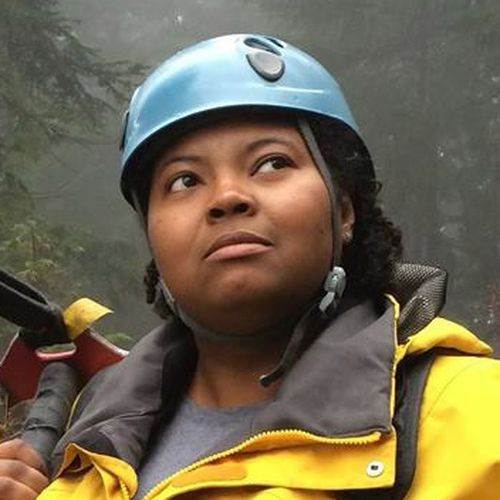Podcast Recap: Danielle Lee Shares How She Inspires a Future Generation of Black Scientists in “Overheard at National Geographic”
Overheard at National Geographic kicked off Black History Month on February 8th with a look at the important work being done by National Geographic Explorer Danielle Lee. In the fourth episode of season 9, co-host Eli Chen interviews Danielle about the scientific research she does, what inspired her to become a scientist, and how she’s trying to open up new doors for another generation of Black scientists. Here’s a recap of the episode titled “The Wonders of Urban Wildlife.”

(National Geographic)
As a child, Danielle Lee spent her summers in parks following her mother, who worked for the Memphis Park Commission. Her mom would give her assignments to keep her busy and through spending a lot of time with nature, she began to pick up patterns and became more curious about the environment. These formative years led to a desire to become a veterinarian, but when she didn’t make it into any veterinary school programs, she shifted her focus to biology.
Danielle originally planned on studying big game, but she developed a passion for rodents and has made them the primary focus of her research for the past two decades. Her work took her to sub-Saharan Africa to study African pouched rats in Tanzania. One of the world’s largest rodents, African pouched rats can reach up to 35-inches in length and have the ability to be trained to detect TNT in land mines. Strong, fast, and agile, African pouched rats also have incredibly sharp teeth and even though Danielle was working with a team and being very careful, she has been bitten by them before.
Part of the conversation includes a discussion of how researchers should approach working in different countries and cultures. As a Black woman wearing fieldwork scrubs, Danielle was the subject of disapproving looks and sneers from locals until she adopted the local style for women, wearing a kanga, a colorful cloth worn around the waist. She didn’t know the local culture either and thought she was being helpful at work when she cleaned her own workstation, unintentionally offending people hired to do that for her. The experience taught her the importance of building relationships with the communities you work in, even if you’re there to study animals and not people.
Danielle also shared how she created “Caring protocols” when she’s doing fieldwork in neighborhoods, primarily needed when working in predominantly white spaces. In the early 2000s as a Ph.D. student studying field mice and prairie voles in central Illinois, residents kept calling the police to report her for suspicious activity. She had permission to be there from the farm owners, but suspicious neighbors kept calling in. Eventually, the local sheriff had to work with her, asking her questions about her work and how long she would be doing it so dispatchers could share the information when they received calls about her. She is now proactive with these steps, showcased in her current research around St. Louis where she is studying mice in both Black and white communities.
Part of Danielle’s current focus is learning why mice and vermin tend to be more present in largely Black urban areas. Part of the reason is city investment in trash services and parks, modern problems that can be traced back to segregation policies from the mid-century. St. Louis has what’s known as the “Delmar Divide,” with the north half of the city predominantly Black. Scientists have discovered noteworthy differences in the wildlife on either side of Delmar Boulevard. Raccoons, for example, don’t mate with populations of raccoons on the other side of the divide, creating two genetically distinct populations within the same city, likely because of the highway and heavy human traffic. The frequency of trash pickup also affects the number of raccoons in an urban area, as do illegal dumping which happens more frequently in these areas. Decades of redlining and disinvestment have created numerous empty lots on the north side of the Delmar Divide, which give Danielle new opportunities to study wildlife literally in people’s backyards, with residents having no clue how close they are to nature. With rodents carrying infectious diseases, it’s important for residents to know what kind of rodents are present in their area and who is most affected by them, particularly people with allergies and asthma.
There’s a social justice element to Danielle Lee’s work, redefining Black spaces as science spaces. She wants to make science spaces accessible to everyone to increase community engagement and help young people of color see science careers as an option for them. She approaches education for Black youth by equating scientific concepts to popular hip-hop songs. In her 2019 Ted Talk, she used “O.P.P.” by Naughty by Nature to talk about the polyamorous relationship of songbirds.
While Danielle Lee’s interest in science began as a child following her mother around, she also talked about one of her heroes in the podcast. Charles Henry Turner was an African American living in St. Louis in the early 1900s with a doctorate in zoology who couldn’t get a job as a professor, so he taught high school instead. He did groundbreaking research on insects, including the behavior of bees around parks. He published more than 70 papers during his career, but his name was mostly buried by history due to improper citations by his contemporaries. The lack of recognition for Charles Henry Turner had a negative impact on scientific progress because his findings weren’t well known and later researchers basically rediscovered what he already knew. With Danielle now doing research in the same parks, she feels like she’s following in Charles Henry Turner’s footsteps.
Get the full story by listening to the full episode here and on YouTube.


